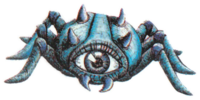Gohma (5e Creature)
Gohma[edit]
|
Large monstrosity, chaotic evil Armor Class 19 (natural armor)
Saving Throws Con +3, Int +0 Magic Resistance. The gohma has advantage on saving throws against spells and other magical effects. Spider Climb. The gohma can climb difficult surfaces, including upside down on ceilings, without needing to make an ability check. Weak Point. An attack which specifically targets the gohma's eye bypasses its damage immunity and resistances. If the attack inflicts piercing damage, it not only bypasses immunity and resistance, but inflicts double damage. Any attack roll made as a called shot, such as against this weak point, is normally made with disadvantage. ACTIONSMultiattack. The gohma makes three attacks. Bite. Melee Weapon Attack: +6 to hit, reach 5 ft., one target. Hit: 10 (2d6 + 3) piercing damage. Sting. Melee Weapon Attack: +6 to hit, reach 5 ft., one target. Hit: 8 (2d4 + 3) piercing damage plus 2 (1d4) poison damage. Fire Bolt. Ranged Spell Attack: +5 to hit, range 120 ft., one target. Hit: 11 (2d10) fire damage.
|
Bearing physiological similarities to both a spider and a crab, the colossal predatory monster known as gohma spans almost 10 feet across. It bears four or six functional legs capable of climbing almost any surface. A gohma's entire body is plated in chitin more dense than iron that protects it from virtually all forms of conventional attack, save for its single imposing eye. Nesting in Darkness. Unlike a mundane spider, a gohma is incapable of producing webbing. It instead makes its home in whatever dark crevices can hide its monstrous frame. This often includes dank caves and the depths of subterranean ruins, which it only leaves to hunt. A gohma is usually the apex predator in its environment, and is more than capable of dragging back prey even larger than hylians and horses back to its lair. Weaponized Offspring. A gohma usually lives either alone or occasionally in a mating pair, though they can birth either asexually or sexually. More often than not, however, gohma larvae are birthed to serve their parents than to grow into adulthood. Larvae are used to track and hunt prey, or as scapegoats for predators. If a larva becomes too large, or is injured beyond repair, it is usually consumed by its parent so that its nutrients won't be wasted. Extremely few larvae manage to live to adulthood.
|
Variant: Pincer Gohma[edit]
|
As its name implies, a pincer gohma has grown an unusually larger crab-like claw it uses to great effect when dismembering prey. This variant gains the following trait. This variant gains the following action. A pincer gohma has a Challenge Rating of 6 (2,300 XP). |
|
Variant: Queen Gohma[edit]
|
A queen gohma lacks the magic prowess and armor of most gohmas, but has enhanced breeding capability. It can even spawn gohma larvae to defend it in the midst of battle. A queen gohma has an AC of 17, and cannot use the fire bolt action. It instead gains the following action: Birth (Recharge 5-6). The gohma produces 3 (1d4 + 1) gohma larvae, which can either appear in the gohma's space or be dropped from the its vantage point on a wall or ceiling. The gohma can choose for any of these gohma to be of the hatching larvae variant. Each larva acts on its own initiative, which is determined when this action is used. |
|
See also[edit]
- Gohma Larva, the newborn offspring of this creature
- Armogohma, a form of gohma that closely resembles a more mundane spider, albeit a Huge one
- Fire Gohma, a Gargantuan form of gohma known to live in magma
- Great Gohma, a Huge and tremendously powerful form of gohma capable of massacring entire armies
Back to Main Page → 5e Homebrew → Creatures
Back to Main Page → 5e Homebrew → Campaign Settings → Hyrule → Bestiary






